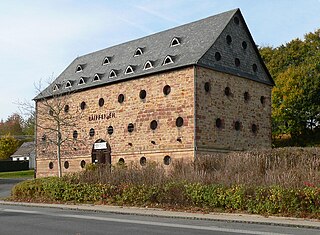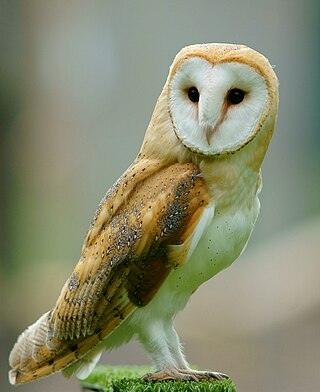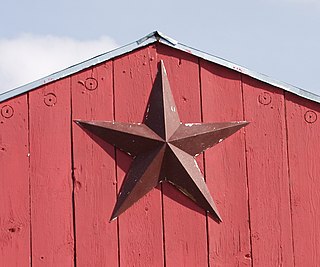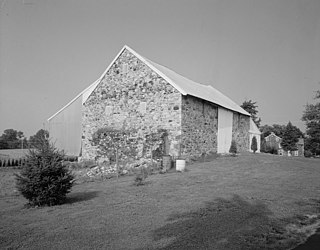
Barn-owls are one of the two families of owls, the other being the true owls or typical owls, Strigidae. They are medium to large owls with large heads and characteristic heart-shaped faces. They have long, strong legs with powerful talons. They also differ from the Strigidae in structural details relating in particular to the sternum and feet.

The barn swallow is the most widespread species of swallow in the world. It appears to have the largest natural distribution of any of the world's passerines, ranging over 251 million square kilometres globally. It is a distinctive passerine bird with blue upperparts and a long, deeply forked tail. It is found in Europe, Asia, Africa and the Americas. In Anglophone Europe it is just called the swallow; in northern Europe it is the only common species called a "swallow" rather than a "martin".

A barn is an agricultural building usually on farms and used for various purposes. In North America, a barn refers to structures that house livestock, including cattle and horses, as well as equipment and fodder, and often grain. As a result, the term barn is often qualified e.g. tobacco barn, dairy barn, cow house, sheep barn, potato barn. In the British Isles, the term barn is restricted mainly to storage structures for unthreshed cereals and fodder, the terms byre or shippon being applied to cow shelters, whereas horses are kept in buildings known as stables. In mainland Europe, however, barns were often part of integrated structures known as byre-dwellings. In addition, barns may be used for equipment storage, as a covered workplace, and for activities such as threshing.

A tithe barn was a type of barn used in much of northern Europe in the Middle Ages for storing rents and tithes. Farmers were required to give one-tenth of their produce to the established church. Tithe barns were usually associated with the village church or rectory, and independent farmers took their tithes there. The village priests did not have to pay tithes—the purpose of the tithe being their support. Some operated their own farms anyway. The former church property has sometimes been converted to village greens.

The barn owl is the most widely distributed species of owl in the world and one of the most widespread of all species of birds, being found almost everywhere except for polar and desert regions, Asia north of the Himalayas, some islands of Indonesia, and some Pacific Islands. It is also known as the common barn owl, to distinguish it from the other species in its family, Tytonidae, which forms one of the two main lineages of living owls, the other being the typical owls (Strigidae).

A barnstar is a painted object or image, often in the shape of a five-pointed star but occasionally in a circular "wagon wheel" style, used to decorate a barn in some parts of the United States. They have no structural purpose but may be considered lucky, akin to a horseshoe mounted over a doorway. They are especially common in Pennsylvania and frequently seen in German-American farming communities. They are also found in Canada, particularly in the province of Ontario.

Burleigh H. Murray Ranch is a property in the state park system of California in the United States. It is a valley ranch located in San Mateo County inland from Half Moon Bay. The ranch was established in 1857 and became a 1,325-acre (536 ha) park in 1979. It was purchased by the State of California in 1983.
Pottery Barn is an American upscale home furnishing store chain and e-commerce company, with retail stores in the United States, Canada, Mexico and Australia. Pottery Barn is a wholly owned subsidiary of Williams-Sonoma, Inc.

The Red Barn restaurant was a fast-food restaurant chain founded in 1961 in Springfield, Ohio, by Don Six, Martin Levine, and Jim Kirst. In 1963, the small chain was purchased by Richard O. Kearns, operated as Red Barn System, with the offices moving briefly to Dayton, Ohio and in August 1964 to Fort Lauderdale, Florida. During the late 1960s United Servomation, also called Servomation, bought the Red Barn chain. In 1978 United Servomation merged with the City Investing Company's GDV division which also owned the Motel 6 motel chain. Only interested in real estate, construction, and financial services the new owners ceased advertising for the chain along with allowing the franchise leases to expire with the last of the leases expiring around 1988. At its peak, Red Barn had 300–400 restaurants in 19 states, as well as outlets in southern Ontario, elsewhere in Canada, and Australia.

Barn Elms is an open space in Barnes in the London Borough of Richmond upon Thames, located on the northerly loop of the River Thames between Barnes and Fulham.

The farm cat, also known as a barn cat, is a domestic cat, usually of mixed breed, that lives primarily outdoors, in a feral or semi-feral condition on agricultural properties, usually sheltering in outbuildings. They eat assorted vermin such as rodents and other small animals that live in or around outbuildings and farm fields. The need for the farm cat may have been the original reason cats were domesticated, to keep rodents from consuming or contaminating grain crops stored for later human consumption. They are still commonly kept for their effectiveness at controlling undesired vermin found on farms, ranches, greenhouses, and even drug farms, which would otherwise eat or contaminate crops, especially grain or feed stocks. Farm cats hunt the initial rodent population, and their pheromones keep further rodents from filling the void.

A round barn is a historic barn design that could be octagonal, polygonal, or circular in plan. Though round barns were not as popular as some other barn designs, their unique shape makes them noticeable. The years from 1880 to 1920 represent the height of round barn construction. Round barn construction in the United States can be divided into two overlapping eras. The first, the octagonal era, spanned from 1850 to 1900. The second, the true circular era, spanned from 1889 to 1936. The overlap meant that round barns of both types, polygonal and circular, were built during the latter part of the nineteenth century. Numerous round barns in the United States are listed on the National Register of Historic Places.

A bank barn or banked barn is a style of barn noted for its accessibility, at ground level, on two separate levels. Often built into the side of a hill or bank, the upper and the lower floors could be accessed from ground level, one area at the top of the hill and the other at the bottom. The second level of a bank barn could also be accessed from a ramp if a hill was unavailable.

Dutch barn is the name given to markedly different types of barns in the United States and Canada, and in the United Kingdom. In the United States, Dutch barns represent the oldest and rarest types of barns. There are relatively few—probably fewer than 600—of these barns still intact. Common features of these barns include a core structure composed of a steep gabled roof, supported by purlin plates and anchor beam posts, the floor and stone piers below. Little of the weight is supported by the curtain wall, which could be removed without affecting the stability of the structure. Large beams of pine or oak bridge the center aisle for animals to provide room for threshing. Entry was through paired doors on the gable ends with a pent roof over them, and smaller animal doors at the corners of the same elevations. The Dutch Barn has a square profile, unlike the more rectangular English or German barns. In the United Kingdom a structure called a Dutch barn is a relatively recent agricultural development meant specifically for hay and straw storage; most examples were built from the 19th century. British Dutch barns represent a type of pole barn in common use today. Design styles range from fixed roof to adjustable roof; some Dutch barns have honeycombed brick walls, which provide ventilation and are decorative as well. Still other British Dutch barns may be found with no walls at all, much like American pole barns.

The Pete French Round Barn, located near Burns, Oregon, United States, is a round barn listed on the National Register of Historic Places. The late 19th century barn was owned and constructed by cattle rancher Peter French; French trained horses there during the winter. The barn was listed on the National Register on September 10, 1971.

Log buildings and structures can be categorized as historic and modern. A diverse selection of their forms and styles with examples of architectural elements is discussed in the following articles:

Kenjon Fa'terrel Barner is an American football running back who is a free agent. He played college football for the University of Oregon and received All-American honors. He was drafted by the Carolina Panthers in the sixth round of the 2013 NFL Draft. Barner has also played for the Los Angeles Chargers, Philadelphia Eagles, New England Patriots, Atlanta Falcons, and Baltimore Ravens.
















